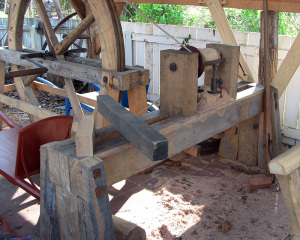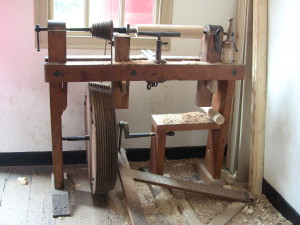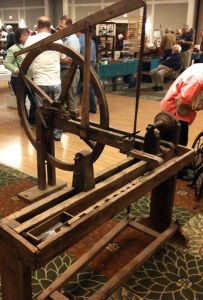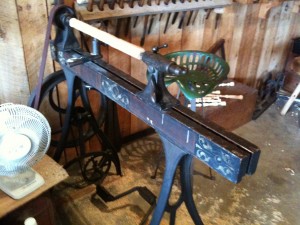Foot Powered Wood Turning
Ever since my first trip to Colonial Williamsburg I have been fascinated with foot powered lathes. This is where all those hybrid woodworkers and power tool guys roll your eyes and click away to something else.
I have been pouring over examples of meat powered lathes in books and online, taking field trips all over the east coast to examine and photograph them, and spending every free minute turning on the Barnes lathe we have at the Steppingstone Museum. So it is with great excitement that I announce I’ll be building both a Spring Pole Lathe and a Treadle Lathe for The Hand Tool School semester 5. Actually the spring pole lathe is already built and I’ll be sharing quite a bit of that build here for free. Hand Tool School members will get the more detailed version but in essence that is a bonus build for Semester 5 since the treadle lathe is the real focus. In my research I have seen some pretty cool lathes and there is so much fuel for my own design. I’m discovering that lathes are a lot like workbenches. So many variables that are personal in nature and so much inspiration that it can be hard to get started on your own design. So to muddy your own waters a little more I present some of the lathes that have inspired me and the elements that will go into my own design.
Great Wheel Lathe at the Wheelwright Shop in Williamsburg
 If only I had an apprentice to turn the great wheel this would be the way to go. However considering I’m not exactly in marathon running form anymore, powering my own lathe is probably a good idea. I like the timber framed, beefy nature of this lathe. You won’t get any vibration on this beast. I like the solid head and tail stocks and the massive pulley on the headstock for greater surface area to grab the belt. It is hard to see in this picture but the pulley is also stepped for variable speed assistance. This is necessary for turning large hub stocks from square to round over a variety of wheel sizes.
If only I had an apprentice to turn the great wheel this would be the way to go. However considering I’m not exactly in marathon running form anymore, powering my own lathe is probably a good idea. I like the timber framed, beefy nature of this lathe. You won’t get any vibration on this beast. I like the solid head and tail stocks and the massive pulley on the headstock for greater surface area to grab the belt. It is hard to see in this picture but the pulley is also stepped for variable speed assistance. This is necessary for turning large hub stocks from square to round over a variety of wheel sizes.
Gunsmith’s Lathe in Williamsburg
 This is a smaller version of the Wheelwright lathe. In this version the stepped pulley remains and a massive flywheel retains a lot of the momentum as a compromise for not having the great wheel. The axle and offset crank is intriguing providing great stability without the need for a third leg to support the flywheel. The half leg that receives the axle also makes a handy tool rest and it did not get in the way while turning at all. Granted I only turned on this lathe for about 5 minutes.
This is a smaller version of the Wheelwright lathe. In this version the stepped pulley remains and a massive flywheel retains a lot of the momentum as a compromise for not having the great wheel. The axle and offset crank is intriguing providing great stability without the need for a third leg to support the flywheel. The half leg that receives the axle also makes a handy tool rest and it did not get in the way while turning at all. Granted I only turned on this lathe for about 5 minutes.
Hybrid Great Wheel from the Brown’s Tool Auction
 Out of the 20 or 30 lathes I have looked at in person this is unique. It incorporates a spring pole like lever arm and a large diameter wheel to achieve great speed with a low treadle frequency. It would be nice to make the wheel more solid to impart greater momentum but at such a large size, this would be tricky and involve a lot of stock. Unfortunately this design takes up way too much space and just isn’t possible in my shop but I do really like the added tool well on the ways. This additional workspace would be helpful for keeping tools and accessories close at hand. Though I imagine everything will very quickly get covered in shavings. I don’t relish sifting through shavings for sharp object, let alone what green shavings could do to steel tools buried in them. The work surface is reminiscent of Stephen Shepherd’s lathe.
Out of the 20 or 30 lathes I have looked at in person this is unique. It incorporates a spring pole like lever arm and a large diameter wheel to achieve great speed with a low treadle frequency. It would be nice to make the wheel more solid to impart greater momentum but at such a large size, this would be tricky and involve a lot of stock. Unfortunately this design takes up way too much space and just isn’t possible in my shop but I do really like the added tool well on the ways. This additional workspace would be helpful for keeping tools and accessories close at hand. Though I imagine everything will very quickly get covered in shavings. I don’t relish sifting through shavings for sharp object, let alone what green shavings could do to steel tools buried in them. The work surface is reminiscent of Stephen Shepherd’s lathe.
Barnes Lathe
 This design steps forward in time a century and therefore should be expected to be more efficient in many ways. The cast iron flywheel weighs over 300 lbs and really hums when you get it turning. Once up to speed, there is very little effort to maintain it. Plus the bicycle style pedals mean you can use both feet and sit comfortably while working. The drawbacks here is with so many iron parts, this design is out of the reach of the average woodworker. Though the inclusion of some more modern parts reminds me how much I like modern drive centers and live centers. I will be sure to include ways to use my existing lathe accessories not only to save money but to increase the functionality and effectiveness of my design.
This design steps forward in time a century and therefore should be expected to be more efficient in many ways. The cast iron flywheel weighs over 300 lbs and really hums when you get it turning. Once up to speed, there is very little effort to maintain it. Plus the bicycle style pedals mean you can use both feet and sit comfortably while working. The drawbacks here is with so many iron parts, this design is out of the reach of the average woodworker. Though the inclusion of some more modern parts reminds me how much I like modern drive centers and live centers. I will be sure to include ways to use my existing lathe accessories not only to save money but to increase the functionality and effectiveness of my design.
Of course there are many more I have seen and worked on (including both of Roy Underhill’s designs) but none of them really add anything majorly different from what I have shown. Roy’s older lathe does incorporate a 3rd leg to support the flywheel on both sides which is a definite bonus in my opinion over his “Lathe from a Loft” design and this will absolutely make it into my design. On the whole, building a treadle lathe is one of those things where you just have to take the leap and figure out some things along the way. Inevitably there will be some things I will want to change but ideally if I can build a strong chassis, I can make changes without having to rebuild the entire lathe. Yet again another similarity to workbenches. I’m really excited about this build and after turning on 8 different lathes and examining photos or visiting at least 25 more, I feel I have a great design that incorporates a little of each. Of course then I get to begin the comparisons between the treadle and spring pole lathes. The lumber is bought and acclimating in my shop, now I just need to finish 20 or 30 other things on the to do list first.
Your Turn
Would you ever build a foot powered lathe? Treadle or Spring pole? What elements are important to you?
Please share your thoughts in the comments section below.


